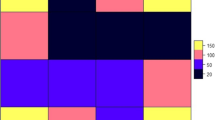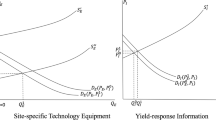Abstract
A better method is needed to evaluate the effectiveness of precision agricultural practices on research farm fields. We present a novel methodology for formulating the design of an experiment to evaluate the effectiveness of precision agricultural practices. The method combines a georeferenced treatment structure and a georeferenced design structure to build a mixed model that describes and analyzes the site-specific experiment. One or more layers of georeferenced information (obtained by various remote-sensing systems) describing the topography of the research field and its crop attributes may be included as covariates in the mixed model. The concepts of this approach are illustrated through the use of a hypothetical field. Current limitations are also discussed.








Similar content being viewed by others
References
Bachmaier M, Gandorfer M (2009) A conceptual framework for judging the precision agriculture hypothesis with regard to site-specific nitrogen application. Precis Agric 10:95–110
Bishop TFA, Lark RM (2006) The geostatistical analysis of experiments at the landscape-scale. Geoderma 133:87–106
Burris E, Burns D, McCarter KS, Overstreet D, Wolcott M, Clawson E (2009) Evaluation of the effects of Telone II (fumigation) on nitrogen management and yield in Louisiana delta cotton. Precis Agric 10 (Published online: 06 August 2009)
Chang K (2006) Introduction to geographic information systems, 3rd edn. McGraw-Hill, New York
Cox MS, Gerard PD (2007) Soil management zone determination by yield stability analysis and classification. Agron J 99:1357–1365
Fleming KL, Westfall DG, Wiens DW, Brodah MC (2000) Evaluating farmer defined management zone maps for variable rate fertilizer application. Precis Agric 2:201–215
Hong N, White JG, Gumpertz ML, Weisz R (2005) Spatial analysis of precision agriculture treatments in randomized complete blocks: guidelines for covariance model selection. Agron J 97:1082–1096
Hooks T, Pedersen JF, Marx DB, Gaussoin RE (2007) Changing the support of a spatial covariate: a simulation study. Crop Sci 47:622–628
Hornung A, Khosla R, Reich R, Inman D, Westfall DG (2006) Comparison of site-specific management zones: soil-color based and yield based. Agron J 98:407–415
Hurley TM, Malzer GL, Kilian B (2004) Estimating site-specific nitrogen crop response functions: a conceptual framework and geostatistical model. Agron J 96:1331–1343
Johnson DH (2006) The many faces of replication. Crop Sci 46:2486–2491
Lamb DW, Frazier P, Adams P (2008) Improving pathways to adoption: putting the right P’s in precision agriculture. Comput Electron Agric 61:4–9
Langley RB (1998) The UTM grid system. GPS World, pp 46–50
Littell RC, Milliken GA, Stroup WA, Wolfinger RD, Schabenberger O (2006) SAS® for mixed models, 2nd edn. SAS Institute, Cary, NC
McCarter KS, Burris E, Milliken GA, Clawson EL, Wong HY, Willers JL (2007) Specifications of a prototype software system for developing variable-rate treatment prescriptions for use in precision agriculture. In: Boyer J (ed) Proceedings of the nineteenth annual Kansas State University conference on applied statistics in agriculture, April 27–May 1, 2007. Manhattan, Kansas, pp 39-61
Mead R (1988) The design of experiments: statistical principles for practical application. Cambridge University, Cambridge
Milliken GA, Johnson DE (2002) Analysis of messy data, vol. 3. Analysis of covariance. Chapman and Hall/CRC, New York
Milliken GA, Johnson DE (2009) Analysis of Messy Data, vol. 1, 2nd edn. Designed Experiments. Chapman and Hall/CRC, New York
Pringle MJ, McBratney AB, Cook SE (2004) Field-scale experiments for site-specific crop management: part II. A geostatistical analysis. Precis Agric 5:159–169
Roudier P, Tisseyre B, Poilvé H, Roger J-M (2008) Management zone delineation using a modified watershed algorithm. Precis Agric 9:233–250
Sadler EJ, Sudduth KA, Jones JW (2008) Separating spatial and temporal sources of variation for model testing in precision agriculture. Precis Agric 8:297–310
SAS Institute Inc (2008) SAS/STAT® 9.2 user’s guide. SAS Institute, Cary, NC
Snyder JP (1987) Map projections—a working manual. US geol surv prof pap 1395. U.S. Gov Print Office, Washington, DC
Sudduth KA, Drummond ST (2007) Yield editor: software for removing errors from crop yield maps. Agron J 99:1471–1482
Theobald DM (2003) GIS concepts and ArcGIS® methods. Conservation Planning Technologies, Fort Collins, CO
Willers JL, Milliken GL, O’Hara CG, Jenkins JN (2004) Information technologies and the design and analysis of site-specific experiments within commercial cotton fields. In: Milliken GA (ed) Proceedings of the sixteenth annual Kansas State University conference on applied statistics in agriculture, April 25-27, 2004, Manhattan, Kans, pp 41-73
Willers JL, Jenkins JN, Ladner WL, Gerard PD, Boykin DL, Hood KB, Mckibben PL, Samson SA, Bethel MM (2005) Site-specific approaches to cotton insect control. Sampling and remote sensing analysis techniques. Precis Agric 6:431–452
Willers JL, Milliken GA, O’Hara CG, Jenkins JN (2008) Defining the experimental unit for the design and analysis of site-specific experiments in commercial cotton fields. Agric Syst 96:237–249
Yang C, Everitt JH, Bradford JM (2004) Airborne hyperspectral imagery and yield monitor data for mapping cotton yield variability. Precis Agric 4:445–461
Acknowledgments
Thanks are expressed to grower cooperators, Kenneth Hood, Perthshire Farms, Gunnison, MS and Paul Good, Good’s Longview Farm, Macon, MS, for their permission and support to work in their fields. Their support led the way for the concepts of this paper. Appreciation is expressed to Mr. Ronald E. Britton, USDA-ARS, Mississippi State, MS for assistance with the preparation of the paper. The efforts of anonymous reviewers and editors whose comments improved the manuscript are appreciated. Approved for publication as Journal Article No. J-11582 of the Mississippi Agricultural and Forestry Experiment Station, Mississippi State University.
Author information
Authors and Affiliations
Corresponding author
Additional information
Mention of a trademark, proprietary product, or vendor does not constitute guarantee or warranty of the product by the US Department of Agriculture and does not imply its approval to the exclusion of other products or vendors that may also be suitable.
Rights and permissions
About this article
Cite this article
Milliken, G., Willers, J., McCarter, K. et al. Designing experiments to evaluate the effectiveness of precision agricultural practices on research fields: part 1 concepts for their formulation. Oper Res Int J 10, 329–348 (2010). https://doi.org/10.1007/s12351-009-0072-4
Received:
Revised:
Accepted:
Published:
Issue Date:
DOI: https://doi.org/10.1007/s12351-009-0072-4




